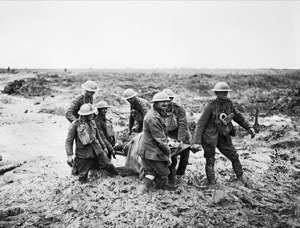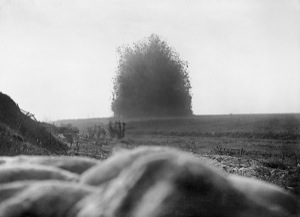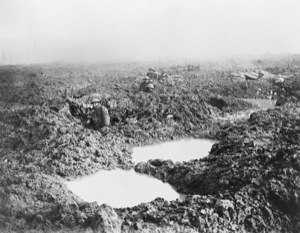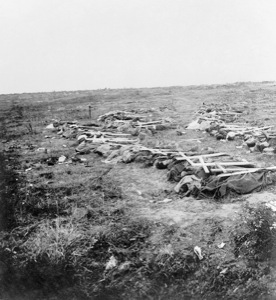The Great War: Photography on the Western Front
By Caitlin Patrick
The military, economic, political and cultural legacies of the 'Great War' are well documented in a range of academic literature, popular books and films. In particular, the horrors of trench warfare on the Western Front have received frequent attention, often in literary and poetic forms produced by combatants. The famous phrase 'lions led by donkeys' encapsulates a popular historical narrative emphasizing the heroism of the average soldier in contrast to the incompetence of senior Army leadership. World War I photography can be used to provide both supporting evidence for such viewpoints but can also tell a different story, one that testifies to the pride, patriotism and camaraderie of the war's combatants and provides a more 'positive' assessment of the conflict, for Britain and her allies at least. (Holmes, 2008) While large volumes of unofficial photographs exist in various personal and public collections, this short essay will focus on some of the Great War's official photographers and their outputs. All the photos shown are part of the Imperial War Museum's archive.
There is little doubt that photography was a part of warfare at all levels for the first time during the Great War, from scientific use for surveying and mapping territory to personal mementos and propaganda material. Small, portable and newly mass-produced Kodak and Brownie cameras were taken to war in 1914 by many officers, and somewhat fewer soldiers, as ways to document their experiences. Not unlike the situation in current and ongoing wars, combatants 'shot' when opportunities arose despite senior ranks' disapproval and an official ban on troop photography in 1915. The commercial sector also caught on to the appeal of photographic souvenirs. Companies like Stevenard in Dunkirk and Lelong in Amiens began producing postcards, usually showing war-damaged towns or cheerful soldiers as uncontroversial war tropes.
The acceptance of photography into newspapers, the choice public news medium of the day, was mixed. Jane Carmichael, in her book First World War Photographers, discusses the reluctance of the higher-end British press to use photos, preferring to maintain its literary traditions. The cheaper end of the market, however, did not have such qualms and the half-tone process, developed in the 1880s, allowed high quality photographs to be mass-printed. Additionally, new serial publications, such as The War Illustrated, were created specifically to provide a pictorial narrative of the conflict. In the face of such technological possibilities and great public interest, British leadership was forced to accept the inevitability of war photography and to consider how it might be integrated into the war effort without leading to dangerous information leaks from their most important theatre of war. The army was used to organising its own censorship but struggled to meet the daily demands of the now-expanded press industry. As Carmichael notes, "The pragmatic solution found during the First World War was to invite a limited number of professionals to be part of a special elite, official reporters, and then to exclude all others as far as possible from the most important areas." (p. 16) The War Propaganda Office had created a department specifically to organise the creation of official pictorial material in August 1914. Official photographs were first to be censored in the field by the military and then sent to the London-based Press Bureau for final censorship and distribution.

(c) Imperial War Museum
J. W. Brooke: Battle of Pilckem Ridge 31 July-2 August, 1917- stretcher bearers struggle in mud up to their knees to carry a wounded man to safety near Boesinghe on 1 August. The look of agonised desperation on the men's faces has made this image a favourite choice to indicate the appalling conditions on the Western Front.
It was March 1916, however, before the first official war photographer was sent onto the Western Front, following much public interest in unofficial photos showing the battle at Gallipoli. Ernest Brooks, who worked for the pictorial newspaper The Daily Mirror and had been in Gallipoli, was selected, with responsibility for covering what was to become a force of over two million British troops. Approximately a dozen official photographers were eventually commissioned to shoot on the Western Front; the major allied dominions involved also ensured that their own troops were documented. Official photographers were made lieutenants and were subject to military discipline. Importantly, however, censorship of their work only affected what photos could be published, not taken, thereby leaving these photographers generally free to choose their subject matter.
As many commentators on the Great War have noted, war at such a massive scale was new and a recurring problem for photographers was how to convey this magnitude. Beyond the more portable options of hand-held folding plate and single lens reflex, official photographers also tried small panoramic or very large field cameras. Brooks and a later Canadian official photographer, William Rider-Rider, both used a Kodak Panoram No. 4, which recorded an arc of 142 degrees on 3.5 x 12 inch roll-film. The first Canadian official photographer started in the field in April 1916, just a month after Brooks, largely due to the influence of Canadian journalist and entrepreneur, Max Aitken, who had intimate access to British circles of power and was determined that Canada's contribution to the war effort be publicized. According to Carmichael, Australia pursued a very different approach. Its war photography was organised by Charles Bean, a journalist trained as an historian who was strongly focused on the creation of a detailed record of Australia's participation, rather than sensation or propaganda. Australia's first war photographer reached the Western Front in November 1916.
The build-up to the first battle of the Somme in July 1916 presented a logistical challenge for newly appointed photographers. Brooks was the only photographer present to cover the huge numbers of British troops, thus it was arranged that his work be supplemented by the Royal Engineers, who had been traditionally responsible for army photography, in order to produce as many photos as possible. The press at home were galvanised by the coming battle. When the bulk of the photos from 1 July 1916 arrived in London a week later, they were widely featured. Despite the special arrangements made by the army for increased photographer numbers and access, heavy artillery bombardments kept many photographers distanced from the front line. Many battle scene photos showed troops only as tiny figures on nondescript landscapes. Regardless of this, journalists and editors recognised the unique window into the conflict that photography gave their audiences. The photo below, taken by Ernest Brooks on the first day of the Somme, indicates the drama that exploding ordnance could offer as a contrast to many close-ups of troop preparation that were also recorded.

(c) Imperial War Museum
Ernest Brooks: The mine under Hawthorn Redoubt is fired at zero minus 10 minutes before the assault on Beaumont Hamel. 45,000 pounds of Ammonal exploded. The mine caused a crater 130 feet across by 54 feet deep. (Battle of the Somme, 1 July- 18 November, 1916)

(c) Imperial War Museum
William Rider-Rider: Men of the 16th Canadian Machine Gun Company holding the line in a landscape of mud and water-filled shell-holes, November 1917.

(c) Imperial War Museum
Frank Hurley and George H. Wilkins: An explicit photograph taken for the record of casualties during the last offensives; bodies of men killed near Guillemont Farm collected for burial.
Click here for 'The Great War' Bibliography section


